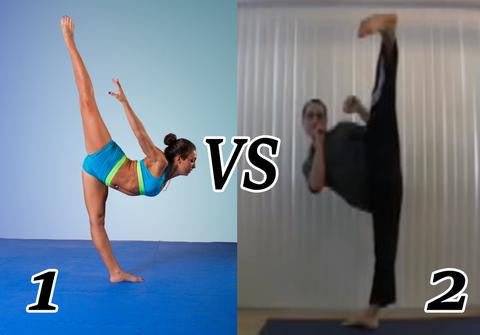Open Front Split Into True Front Split
Posted by EasyFlexibility Team on
Whenever I meet people, I can be sure there will be stretching and flexibility questions coming my way. One question that comes up often had to do with the front split. Actually with the front Split(s).
How do I "Convert" my Open (Turned Out) Front Split into the True (Squared) Front Split?
Of course one of the answers is we have a program for that. Dahhh. But in this article I would like to get a bit deeper. So what is missing? Why can someone do this split:

...and not this split:

The answer is found in one of the following muscles:
- Lateral Hamstrings (Biceps Femoris) On the Front Leg
- Psoas, Illiacus, Sartorius and rarely Rectus Femoris on the rear leg.
Before moving on... You should understand something. Not all Front Splits are the same. Oh no, no, no.
The True Front Split
You see there are two ways to do a True Front Split (TFS). One is Structural and One is Functional. (Explanation here)
- Structural one is gold standard and most people don't have it. Even flexible ones.
- Functional is what most people do when they do the TFS. It's a split in function (legs are apart), but in structure, it's a glorified hamstrings stretch with deep back hyper extension.
If your goal is Structural TFS you probably have enough hamstrings flexibility and you need to hit the hip flexors and upper adductors hard. Since all you need is 90 degrees at the hamstrings (no biggie), and you need 90 at hip flexors (BIGGIE!!!) Here is how to do it.
On the other hand if you just want Functional TFS, you would figure out where the issue is. Or you can just do the TFS program. (Click here).
The Open Front Split
The only muscles that prefer the turnout position (Open Front Split) and thus would prevent a turned in position (TFS) in the rear leg are:
- Iliopsoas
- Sartorius
- and Rectus Femoris.
The Beauty of the ZS Technique
Here is where the beauty of ZST (Zaichik Stretching Techniques) comes in. Unlike standard stretches which hit all the muscles at the same time, ZST can isolate the "offending" tight muscles and quickly stretch them.
The result is quick split. BAM! Boom! Paw!
P.S. Did you know that EasyFlexibility is coming out with Second Edition of Split Programs? More tailored to your flexibility level for even faster progress. Stay tuned!!!











